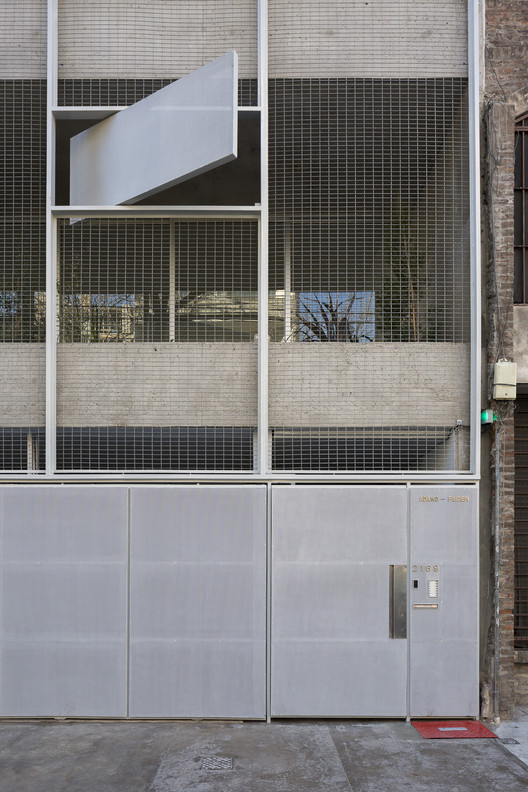Vroenhoven Bridge Ney-Partners
2013-09-24 01:00
Text description provided by the architects. Program
与艺术家Jozef LeGrand合作,完成对结构、建筑和景观的研究。项目通过公开比赛获胜。
Complete study of structure, architecture and landscape in collaboration with the artist Jozef Legrand. Project won through an open competition.
连接安特卫普和列日的艾伯特运河已被拓宽,用于河流交通达9000吨。这座新桥的中心跨度为100米,允许划船的自由宽度为86米。这种干预的条件非常复杂,因为该遗址是历史上保存的。就在这个地方,比利时开始了第二次世界大战。桥旁的掩体证明了这个时代。
The Albert Canal, connecting Antwerp with Liège, has been broadened for river traffic up to 9000 tons. The new bridge has a central span of 100m, which allows for a free width of 86m for boat passage. The conditions for this intervention are highly complex since the site is historically preserved. At this very spot, the Second World War started for Belgium. The bunker next to the bridge testifies of this era.
这座桥是一座全长195米的斜拉桥。它的甲板由两条宽3.25米的车道组成,相邻的行人和自行车路线也是如此。桥面的总宽度为18米。主桥体系由两根变高钢梁组成。形状根据梁的应力作用而变化,从甲板上可以看到物化的力图。这些横梁一方面用于分隔交通繁忙的车辆和行人或骑自行车者,另一方面用于将大桥推到确定的位置。
The bridge is a stayed structure with a total length of 195 m. Its deck consists of two lanes of 3.25m width with adjacent pedestrian and cycle routes. The total width of the bridge deck is 18,5m. The main structural bridge system consists of two steel beams with variable height. The form varies according to the stresses acting of the beams, resulting in a materialised force diagram visible from the deck. These beams are used on the one hand for separation of heavy traffic and pedestrians or cyclists, on the other hand for pushing the bridge to its definitive location.
这座桥分两阶段建造。它首先通过推杆与现有桥梁平行放置,并作为临时通道使用约18个月。在第二阶段,拆除现有的结构,对桥梁进行横向撕裂,以取代以前的结构。里姆斯特一侧的桥梁支架是一座巨大的建筑,它将博物馆的功能和桥梁的结构桥台结合起来。建筑物在桥下展开,并构成一个视觉连接(在桥梁和场地之间)和时间连接(指站点的历史)。
The bridge was constructed in two phases. It was firstly placed in parallel to the existing bridge by pushing and was used as a temporary passage for about 18 months. In the second phase the existing structure was demolished and the bridge was ripped laterally to substitute the previous structure. The bridge support on the Riemst side is a massive construction that combines the functions of a museum and a structural abutment for the bridge. The building is spread under the bridge and constitutes a connection that is both visual (between the bridge and the site) and temporal (referring to the site's history).
博物馆整合了几个多功能空间、一家咖啡馆/餐厅和一个举办文化活动的圆形剧场。建筑物的外墙长170米,由变形混凝土制成,可用作攀爬墙。这座大楼的重点是第二次世界大战的信息中心。战争的故事是用多媒体元素以艺术的方式来说明的。作为70年前德国入侵的唯一见证,原来的掩体在新建筑上被维护。特别注意道路工程及其在不同施工阶段的影响,因为该项目是从马斯特里赫特来到佛兰德地区的一个地标门。
The museum integrates several multifunctional spaces, a café/restaurant and an amphitheatre where cultural activities are organised. The external walls of the building are 170 m long and made of textured concrete so that they can be used as climbing walls. The focus of this building is the information centre on Second World War. The tale of the war is illustrated in an artistic way using multimedia elements. The original bunker is maintained over the new building as the sole witness of the German invasion that took place 70 years ago. Particular attention was given to the road works and their implication through the different construction phases, since the project is a landmark gate to the Flanders region for visitors coming from Maastricht.
 举报
举报
别默默的看了,快登录帮我评论一下吧!:)
注册
登录
更多评论
相关文章
-

描边风设计中,最容易犯的8种问题分析
2018年走过了四分之一,LOGO设计趋势也清晰了LOGO设计
-

描边风设计中,最容易犯的8种问题分析
2018年走过了四分之一,LOGO设计趋势也清晰了LOGO设计
-

描边风设计中,最容易犯的8种问题分析
2018年走过了四分之一,LOGO设计趋势也清晰了LOGO设计




















































